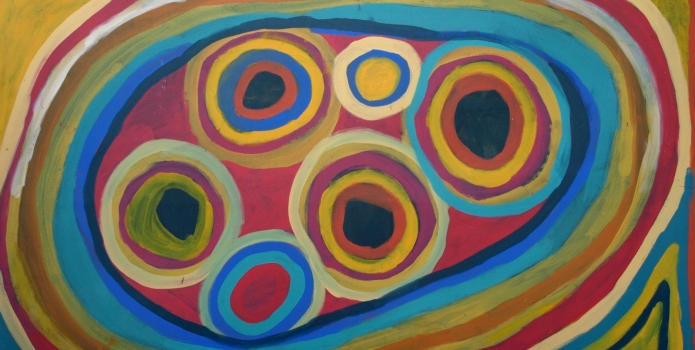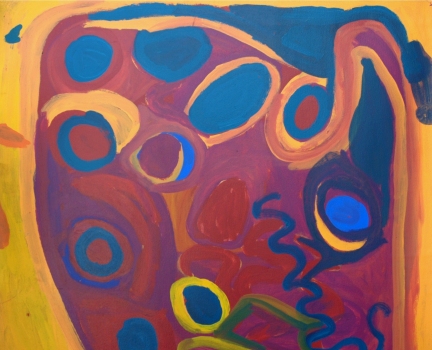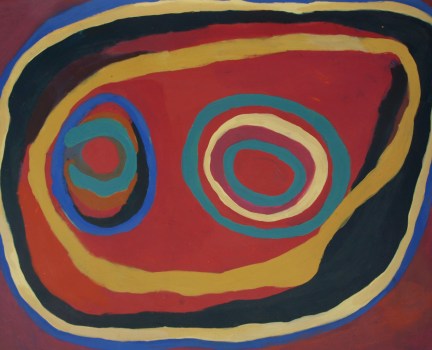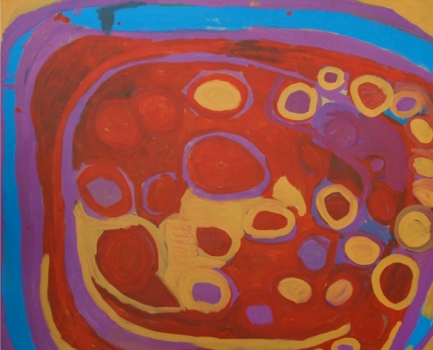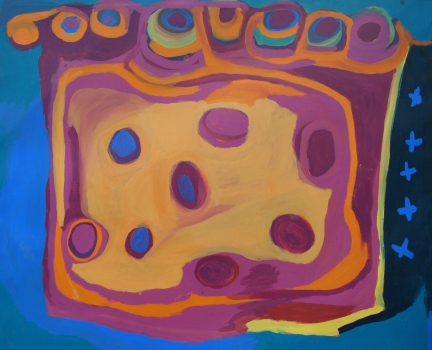Waterhole Dreaming Ngupawarlu
Ngupawarlu is a waterhole out near Well 39 on the Canning Stock Route deep within the desert country of Central Western Australia. Ngupawarlu was the birthplace and spiritual home for Kimberley artist Nyuju Stumpy Brown (1924- 2011). Stumpy Brown became a well known artist at Fitzroy Crossing and Wangkatjungka community in the Kimberley region. Stumpy Brown is the sister to the famous Aboriginal artist Rover Thomas.
Stumpy Brown painted boldly coloured representations of her ancestral country at Ngupawarlu. Her images sing out with an intensity that highlights the spiritual significance of this country to her identity as a painter and as a cultural lawwoman.
Stumpy says of her country - "My country is Ngupawarlu, near the Canning Stock Route. It’s living water, but salty one. You can drink him during cold time, but not when he’s hot – gets too salty. One woman travelled there in the Dreamtime. Whole lot of women were travelling, stopped at that place Ngupawarlu. They were travelling on Law business. They were a big mob – going south-east, Alice Springs way. There’s trees all around– they hide that waterhole. Then sandhills, jilji country all around. It’s like a big lake, trees growing in the water. You can drink from the side of lake – too salty in the middle."
Stumpy Brown has been painting images of her desert homelands and ceremonial country since the mid 1980s in Fitzroy Crossing. She has always been an important figure for Law and culture, carrying the Women's Law from Wangkatjungka side right through to desert side at Balgo. At Nyanpi (corroboree) time, Stumpy ran the ceremonies for young children. She describes the ceremonies - "No sleep. All night making Nyanpi right through to daylight. Then we go back to sleep."
Stumpy Brown says of her early life - "I was born among the sandhills, in my own country. There were no white people. We slept without blankets. All we had was a fire to keep us warm. Yeah. We wore no clothes, completely naked. We used to travel around and go hunting on foot. We'd catch large goannas, bandicoots, blue tongue lizards and possums. We'd eat every bit of these animals, even crush the bones and eat them too."
"My father and mother would both go hunting. My sister and I would stay near the camp and hunt for small lizards. We'd track thorny devils, following its tiny tracks, until we would find one feasting on ants. We would catch it and look around for more. Then we would cook them up." Stumpy describes her country as "desert country. There are no rivers, we never see running water like rivers, only creeks after the rain, only jilji (sandhills)."
Stumpy Brown was part of the great migration of Aboriginal people out of the desert that had begun in the 1920s when the Canning Stock Route had been established deep into her family’s ancestral country. Stumpy Brown made the long journey on foot when she was a young girl, after the death of her parents. Stumpy says - "My uncle was a stockman. He'd been all the way to Wiluna. He guided us part of the way to Balgo Mission then we made our own way. We had no food so we ate bush tucker along the way. We got there and met the priest. He gave us lollies. No flour. Later on, we traded bush tucker for flour and other things. That's where we learnt about white man's ways. We didn't know about white people before that."
Artists like Nyuju Stumpy Brown give us some connection to the very remote waterholes of the inland desert country that was home to the artist’s family for possibly thousands of years. Her richly coloured paintings of Ngupawarlu show her strong regard for this country and the meaning it has for the history of her people.
Further reading:
Back to Aboriginal Dreamtime Stories

